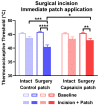Development of Capsaicin-Containing Analgesic Silicone-Based Transdermal Patches
- PMID: 36297391
- PMCID: PMC9611826
- DOI: 10.3390/ph15101279
Development of Capsaicin-Containing Analgesic Silicone-Based Transdermal Patches
Abstract
Transdermal therapeutic systems (TTSs) enable convenient dosing in drug therapy. Modified silicone-polymer-based patches are well-controlled and cost-effective matrix diffusion systems. In the present study, we investigated the substance release properties, skin penetration, and analgesic effect of this type of TTS loaded with low-dose capsaicin. Release properties were measured in Franz diffusion cell and continuous flow-through cell approaches. Capsaicin was detected with HPLC-UV and UV spectrophotometry. Raman spectroscopy was conducted on human skin samples exposed to the TTS. A surgical incision or carrageenan injection was performed on one hind paw of male Wistar rats. TTSs were applied to the epilated dorsal skin. Patches were kept on the animals for 6 h. The thermal hyperalgesia and mechanical pain threshold of the hind paws were detected. Patches exhibited controlled, zero-order kinetic capsaicin release. According to the Raman mapping, capsaicin penetrated into the epidermis and dermis of human skin, where the target receptors are expressed. The thermal pain threshold drop of the operated rat paws was reversed by capsaicin treatment compared to that of animals treated with control patches. It was concluded that our modified silicone-polymer-based capsaicin-containing TTS is suitable for the relief of traumatic and inflammatory pain.
Keywords: addition polymer; capsaicin; silicone; transdermal therapeutic system.
Conflict of interest statement
The authors declare no conflict of interest.
Figures













References
-
- Mojsiewicz-Pieńkowska K., Jamrógiewicz M., Zebrowska M., Sznitowska M., Centkowska K. Technology of an Adhesive Silicone Film as Drug Carrier in Transdermal Therapy. I: Analytical Methods Used for Characterization and Design of the Universal Elastomer Layers. J. Pharm. Biomed. Anal. 2011;56:131–138. doi: 10.1016/j.jpba.2011.04.011. - DOI - PubMed
-
- Tomanek A. Silicone und Technik. Hanser, Carl; München, Germany: 1990.
Grants and funding
LinkOut - more resources
Full Text Sources

